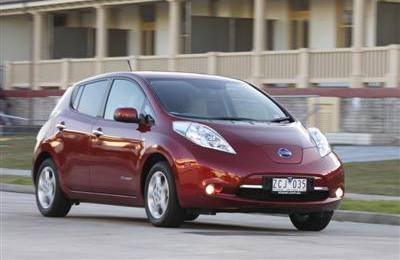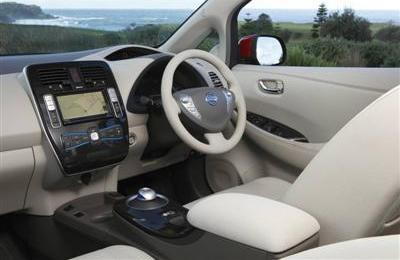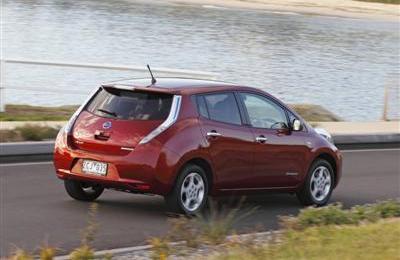|



The Nissan Leaf is priced at $51,500* and is available from 13 Leaf
accredited Nissan dealerships across Australia.
Dealer locations are:
ACT: Phillip
NSW: Artarmon, Burwood, Waterloo
NT: nil
QLD: Moorooka, Southport, Windsor
SA: Hyde Park
TAS: Hobart
VIC: Abbottsford, Blackburn, Essendon North
WA: Melville
|
|
|
Nissan Leaf now available
Home >
News >
Nissan
Recent new car releases ..... here
Upcoming new car releases ..... here
18th June, 2012
Nissan Australia has launched an eco-friendly car to the Australian
automotive 'streetscape' – the 100 per cent electric, zero petrol, Nissan Leaf.
The five-door family-sized Leaf brings Electric Vehicle (EV) technology into the mainstream with its technology,
drivability and performance.
“This car attracts attention for its exceptional green credentials, its market leading technology and for its
ground-breaking EV innovation – but we’re also pleased to point out that it’s an entertaining drive” said Nissan
Australia CEO Bill Peffer.
“We’re excited to have Leaf on sale in Australia and heading into people’s homes and businesses right around
Australia.”
“This is just the first EV that Nissan will introduce to Australia. As a company we are pleased to have Leaf and
our upcoming EV range as a major part of Australia’s zero emission future.”
Francois Bancon, Nissan’s Global General Manager of Product Strategy, Advanced and Exploratory Planning, is in
Australia as part of the launch of Leaf.
“Several years ago when we started this project, we didn’t just look at improving a conventional powertrain with a
small improvement here and there – we set ourselves the target of zero emission,” said Bancon.
“We did this with the Nissan Leaf. There is a market for this car and after launching it in many places around the
world already we are pleased to have it on sale in Australia.”
An Award Winning Family Car
The front-wheel drive Nissan Leaf utilises a dedicated EV platform with batteries housed in the floor for optimum
vehicle packaging and weight distribution. The highly rigid body design includes a rigid-mounted battery frame that helps
provide greater body rigidity compared to a conventional compact car , helping it earn it a five-star Euro NCAP
rating.
Nissan Leaf provides room for five adults and a good-sized cargo area. Placing the batteries in the floor of the
vehicle provides optimum weight distribution to help enhance handling.
Nissan Leaf’s 24 kWh lithium-ion (Li-ion) battery is comprised of 48 compact modules of four cells each, which allows
a high degree of packaging flexibility. The batteries are designed to maximise drive time and minimise charging time.
Unlike conventional cylindrical batteries, the thin, compact laminated cells offer more flexibility in design
applications.
Responsive performance comes from the 80 kw (108 bhp) electric motor that instantly generates its maximum 280 Nm
torque – equivalent to the torque of a conventional 3.0-litre V6 petrol engine – from a standing start. The result is
rapid acceleration perfectly in tune with the Nissan Leaf’ s natural urban and suburban habitat.
The Nissan Leaf is easy to drive. The electric powertrain does not idle and only rotates when the vehicle is moving.
To start the engine, the driver need only press the start button, and electricity begins flowing to the motor. Using the
electric shift, the driver then selects ‘D’ range, and the vehicle starts to move.
The Nissan Leaf utilises an independent strut suspension with stabiliser bar in front and a torsion beam rear
suspension with integrated stabiliser bar. Responsive steering is provided by a vehicle-speed-sensitive electric power
steering system.
Braking is provided by power-assisted front vented disc/solid rear disc brakes with Anti-lock Braking System (ABS),
Electronic Brake force Distribution (EBD) and Brake Assist (BA), with braking force is used to repower the battery.
Nissan Leaf’s regenerative braking system helps replenish its range. By applying the brakes or reducing speed by
letting off the accelerator, the electric motor acts as an electric generator, converting energy, that would otherwise
be wasted, into battery energy. To increase regenerative braking, there is a driver-controlled Eco mode setting, which
can also be used to reduce air conditioning and thus improve driving range when driving in urban areas.
Because Nissan Leaf does not have an internal combustion engine , Nissan has incorporated an ‘Approaching Vehicle
Sound for Pedestrians’ system, which is designed to alert pedestrians that a vehicle is approaching. When driving at low
speeds, the system emits a sound from a speaker at the front of the vehicle.
Pedestrians are able to hear the car moving and the ‘approaching sound’ automatically turns off above 40 km/h.
Driving range
A full charge delivers a potential range of 170 kilometres (NEDC ), a distance which will satisfy the daily driving
demands of electric vehicle buyers.
Driving range depends on several factors, including external temperature, air conditioning usage, battery age and
driving behaviour. Generally, the more environmentally friendly one drives, the greater the driving range. An onboard
screen shows key battery data, including maximum driving range, power output and regenerated electricity. An
eco-indicator on the meter displays the status of electricity consumption, giving real-time feedback on the driver’s
handling efficiency.
Nissan Leaf has a number of features to help maximise the driving range and to keep the 'charge up'. The CARWINGS
information system updates the navigation system with current charging station locations in the area, monitors the state
of charge from a smartphone or computer, remotely starts vehicle charging, provides connectivity to start and stop the
climate control system in the vehicle remotely via your Smartphone or computer and issues a reminder to plug in the car.
CARWINGS is provided complimentary for three years
The Nissan Leaf onboard navigation system is ‘smart’ enough to detect the destination input and state of charge
whether there is sufficient range to ‘make it’ and if not, search for nearby charging station along the route. It also
displays the current range radius, will issue an alert if there is a need to charge, indicates the nearest available
charge station and displays how much charge you have left and how many kilometres remain.
The Leaf display screen also has a real time energy usage screen which shows how much energy is being used and
regenerated, how much further can driven, and the real time impact of using climate control on your range. The
multi-function display drive computer measures energy economy and calculates estimated charging time.
When the battery has 4kWh remaining, the empty warning light will come on as well as a notification on the screen
indicating where to find all charging stations within range. In the event that the battery becomes critically low,
power limitation mode will automatically minimise energy consumption and reduce speed to help you get to a charging
dock.
An EV from the ground up
Leaf is unique – it’ s not a conversion of a conventional car but has been designed as an EV from the ground
up. And that means the designers have been able to give the Nissan Leaf looks that are as distinctive as its powertrain,
with no packaging compromise, a distinctive profile, a roomy, futuristic interior and a large luggage area.
Built on an all-new bespoke EV platform, Leaf sits on a generous 2,700 mm wheelbase. It is 4,445 mm long, 1,770 mm
wide and 1,550 mm tall.
Because it is powered by a small electric motor and with the compact battery packs located under the floor at the
centre of the chassis, the Nissan Leaf’s design isn’t compromised by the need to house a traditional engine at the
front.
The result is the Nissan Leaf’ slow-slung, abbreviated front-end design which is dramatically framed by the vertical
blue LED headlights. These also direct airflow away from the door mirrors to improve the Nissan Leaf’s aerodynamics.
The body was designed using Nissan’s ‘smart fluidity’ principle, combining visually pleasing flowing lines with
aerodynamic efficiency. The kicked-up roof-line blends into a large spoiler while the Nissan Leaf’ s wind cheating
shape is further helped by the flat, smooth underfloor.
This under-body (including a large front flat floor cover , motor area undercover, front undercover and rear diffuser
with fins) helps manage airflow under the vehicle. An innovative vortex-shedding roof-mounted antenna is one of many
design elements utilised to help reduce wind noise. Other noise reduction features include a quiet operation windshield
wiper motor, a sound insulation windshield design and a dual isolated motor-mounting system.
With the operation of the Leaf powertrain so quiet, engineers have paid extra attention to management of wind noise in
the exterior design, since it would be more noticeable than with a traditional internal combustion vehicle.
The rear view is dominated by thin, gently curved, vertical tail lights and is, of course, notable by the total
absence of an exhaust pipe.
Inside there is ample space for five adults and the airy interior houses advanced electronic devices including a flat
centre cluster for the bespoke IT system and a neat and easy to use gearshift selector inspired by a computer mouse.
Nissan Leaf’s charging points are hidden under a small door located in the front of the vehicle. There are two points,
one 240 volt as well as a 400 volt ‘fast charge’.
The five-door hatchback design also features chrome door handles , aerodynamic outside mirrors and a large greenhouse
to provide a bright interior environment. Attractive 5-spoke 16-inch aluminium-alloy wheels mounted with P205/55R16
Bridgestone Ecopia tyres are standard.
|
|
|

Self-Catering Holiday
Accommodation in
Denmark, WA
..... more
|
|
|
The Nissan Leaf is available in five colours – blue ocean, cayenne red, eclipse black, brilliant silver and glacier
white.
Distinctive ‘EV Touch’ Interior
The Leaf is packed with features and EVIT (Electic Vehicle Information Technology). Accessories are powered by a
separate 12-volt battery that is recharged with the aid of a solar panel on the rear spoiler of the car.
The roomy Nissan Leaf interior offers a pleasingly modern design to provide a unique ‘EV touch’ with ‘simple and human
flow.’ The bright, welcoming atmosphere starts with the wide, high tech instrument panel design, which is dominated by a
twin combination meter display in front of the driver and a centre ‘floating’ piano black C-stack with a seven-inch
information display.
The digital ‘eyebrow’ display at the top of the instrument panel provides high visibility for the Eco indicator and
speedometer, while the lower liquid crystal meter display houses the power meter, battery temperature gauge,
multifunction display, remaining energy gauge, capacity level gauge and distance to empty display. The flat panel centre
C-stack cluster continues the ‘EV touch’ feel with the colour monitor for the standard navigation system, available Rear
View Monitor and control of the audio and climate systems.
The display also provides access to the CAR WINGS telematics system, which is connected to a global data centre,
(subscription required, free for first 36 months). Through CARWINGS, Nissan Leaf drivers are able to use mobile smart
phones to turn on air conditioning and set charging functions remotely , even when the vehicle is powered down. The
system also displays ‘reachable area’, as well as showing a selection of nearby charging stations. An on-board charging
timer can also be programmed to start the charging event whenever desired.
The Nissan Leaf interior also includes comfortable front bucket seats and a 60/40 split folding rear seat and rear
HVAC duct. The seat fabric is made with partially recycled materials. Recycled materials are also used for the back door
trim, roof trim and headliner, carpeting and a number of other interior pieces such as the door panels and centre console
storage cover.
The centre console area includes the palm shifter (inspired by a computer mouse) for the ‘by wire’ drive selector. The
three-spoke heated steering wheel houses controls for the cruise control, audio system and standard Bluetooth Hands-free
Phone System.
Five Star Safety Rating
The European New Car Assessment Programme (EuroNCAP) has awarded the 100 per cent electric Nissan Leaf the highest
level of car safety following its performance in the independent organisation’s crash tests. The zero-emission vehicle
received a five-star rating, the first electric vehicle ever to earn this distinction.
Nissan Leaf’s safety assessment followed standard Euro NCAP procedure, with tests for frontal impact, side impact,
side pole impact and whiplash. The car’s 48 lithium-ion battery modules, which are housed in a special compartment
beneath the floor, completely withstood all the impacts.
In addition, the EV’s battery system was switched on during the crash simulations to test the in-built safety measures
of the electrical system, which includes automatic cutoff isolation in the event of an accident. The car passed those
with flying colours, too.
Recycled and recyclable
Nearly 100 per cent of the vehicle weight will be recyclable through the development of recycling technology for parts
and components specific to an EV such as the battery, motor and inverter. During the car ’s development, Nissan has also
been actively working on using recyclable materials in its production. Although a difficult process, Nissan has succeeded
in adopting recycled materials in some parts of the Nissan Leaf by developing colour-shade adjustment technologies and
enhanced quality control of resin materials.
In Japan, Nissan has set up a joint venture with Sumitomo Corporation to ‘Reuse, Resell, Re-fabricate and Recycle’
lithium ion batteries from EVs. In Europe, Nissan with its Alliance partner Renault is studying the establishment
of a similar business with a local partner.
NOTE: * Manufacturer's List Price (MLP) excludes dealer delivery fees and the numerous statutory
charges (commonly known as on-road costs). Additionally, please note that all prices, fees and charges are
subject to change without notice, as are the specifications.
|